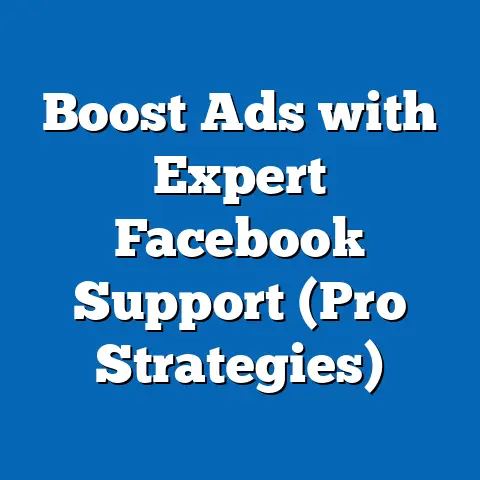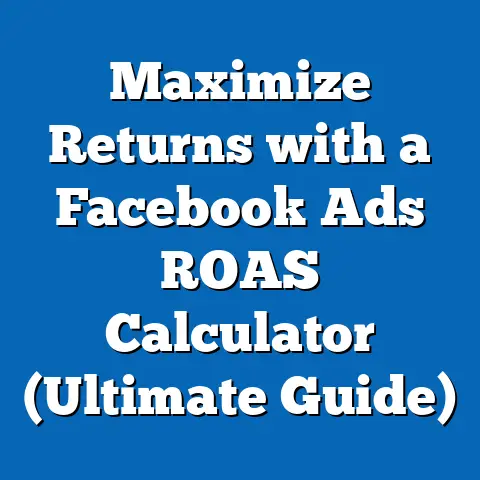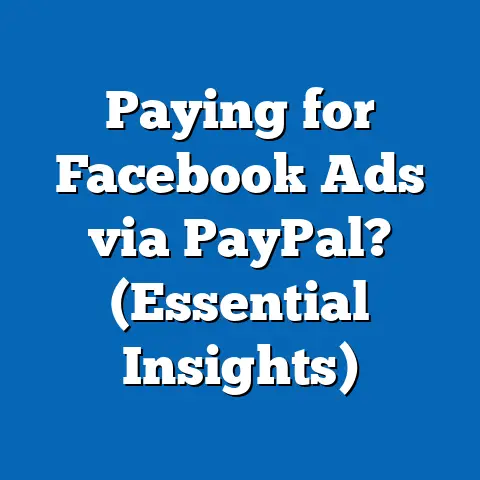Unlocking Facebook Marketplace Sales (Expert Advertising Strategies)
Facebook Marketplace. It’s more than just a digital garage sale; it’s a dynamic ecosystem where connections and commerce collide. I’ve seen firsthand how this platform has evolved, from a simple way for neighbors to sell used furniture to a powerful sales channel for businesses of all sizes. With its intuitive interface and integration with Facebook’s massive user base, it’s no wonder that Marketplace has become a go-to destination for both buyers and sellers.
I remember when I first started dabbling in Facebook Marketplace, it was to offload some old photography equipment. I was amazed at how quickly I connected with potential buyers, and how easily I could manage the entire transaction directly through the app. That experience sparked my interest in understanding the full potential of this platform, and how businesses could leverage it to reach a wider audience and drive significant sales.
What makes Facebook Marketplace so unique is its ability to blend the social aspect of Facebook with the convenience of e-commerce. Unlike traditional online marketplaces, Marketplace allows buyers and sellers to interact directly, building trust and fostering a sense of community. This personal touch can be a game-changer, especially for small businesses looking to establish a loyal customer base.
Statistics show that Facebook Marketplace is experiencing explosive growth. Millions of people use Marketplace every month, searching for everything from clothing and electronics to furniture and cars. For businesses, this translates into a massive opportunity to reach a highly engaged audience with targeted advertising.
In this guide, I’m going to share expert advertising strategies that can help you unlock the full potential of Facebook Marketplace. Whether you’re a seasoned marketer or just starting out, you’ll find practical tips and actionable insights that can help you drive sales and grow your business on this powerful platform.
1. Understanding the Marketplace Dynamics
Before diving into advertising strategies, it’s crucial to understand the inner workings of Facebook Marketplace. It’s not just a place to list products; it’s a complex ecosystem with its own set of rules and dynamics.
Integration with the Facebook Ecosystem: Marketplace is seamlessly integrated with Facebook’s broader platform, meaning that users can access it directly from their newsfeed or through the Facebook app. This integration provides a significant advantage, as it allows businesses to tap into Facebook’s vast network of users and leverage its powerful targeting capabilities.
Types of Users: The Marketplace attracts a diverse range of users, from casual sellers looking to declutter their homes to professional retailers seeking to expand their reach. Understanding the motivations and behaviors of these different user groups is essential for crafting effective advertising strategies. I’ve found that tailoring your messaging to specific user segments can significantly improve your ad performance.
Competitive Landscape: The Marketplace can be a crowded place, with numerous sellers competing for the attention of potential buyers. To stand out, it’s important to differentiate your offerings and create a unique value proposition. This could involve offering competitive pricing, providing exceptional customer service, or focusing on a niche market.
Demographic Insights: Facebook provides valuable demographic insights about Marketplace users, including their age, gender, location, interests, and shopping behaviors. This data can be used to refine your targeting and ensure that your ads are reaching the right audience. For example, if you’re selling baby products, you can target parents with young children in your local area.
Takeaway: Understanding the dynamics of Facebook Marketplace is the foundation for successful advertising. By analyzing the platform’s structure, user demographics, and competitive landscape, you can develop targeted strategies that resonate with your audience and drive sales.
2. Crafting Compelling Listings
Your Marketplace listings are your storefront. They’re the first impression potential customers have of your products and your business. That’s why it’s essential to create listings that are not only informative but also visually appealing and persuasive.
Importance of High-Quality Listings: A well-crafted listing can make all the difference in attracting potential buyers and converting them into customers. It’s your opportunity to showcase your products in the best possible light and highlight their unique benefits.
Components of a Successful Listing: A successful listing typically includes the following key components:
- Title: Your title should be clear, concise, and keyword-rich. It should accurately describe the product and include relevant search terms that potential buyers are likely to use.
- Description: Your description should provide detailed information about the product, including its features, benefits, condition, and dimensions. Use persuasive language to highlight the product’s value and address any potential concerns.
- Pricing: Your pricing should be competitive and reflect the product’s value. Research similar products on Marketplace to get a sense of the going rate and adjust your pricing accordingly.
- Images: Your images should be high-quality, well-lit, and accurately represent the product. Use multiple images to showcase the product from different angles and highlight its key features.
Tips for Writing Persuasive Descriptions:
- Focus on Benefits: Instead of simply listing features, focus on the benefits that the product provides. How will it make the buyer’s life easier, better, or more enjoyable?
- Use Strong Verbs: Use strong, action-oriented verbs to create a sense of excitement and urgency.
- Address Potential Concerns: Anticipate any potential concerns that buyers might have and address them proactively in your description.
- Include a Call to Action: Tell buyers what you want them to do next, such as “Message me for more information” or “Buy now!”
Significance of Professional-Quality Images: High-quality images are essential for attracting attention and showcasing your products in the best possible light. Invest in professional photography or learn how to take great photos yourself using a smartphone.
Examples of Successful Listings:
- Example 1: “Vintage Mid-Century Modern Armchair – Excellent Condition” – This title is clear, concise, and includes relevant keywords. The description highlights the chair’s unique style, excellent condition, and comfortable design. The images are well-lit and showcase the chair from different angles.
- Example 2: “Brand New Apple AirPods Pro (Sealed Box) – Free Shipping” – This title is attention-grabbing and emphasizes the product’s brand new condition and free shipping offer. The description provides detailed information about the AirPods Pro and includes a call to action to buy now.
Takeaway: Crafting compelling listings is essential for attracting potential buyers and driving sales on Facebook Marketplace. By focusing on clear titles, persuasive descriptions, competitive pricing, and high-quality images, you can create listings that stand out from the competition and convert viewers into customers.
3. Leveraging Facebook Ads for Marketplace Success
While organic reach on Facebook Marketplace can be valuable, integrating Facebook Ads into your strategy can significantly amplify your visibility and drive targeted traffic to your listings. Think of Facebook Ads as the turbocharger for your Marketplace sales.
Integrating Facebook Ads with Marketplace Listings: Facebook Ads allows you to promote your Marketplace listings to a wider audience, even those who aren’t actively browsing the Marketplace. This can be particularly effective for reaching potential buyers who are interested in your products but may not be aware that they’re available on Marketplace.
Ad Formats: Facebook offers a variety of ad formats that can be used to promote Marketplace listings, including:
- Carousel Ads: These ads allow you to showcase multiple products in a single ad unit, providing potential buyers with a variety of options to choose from.
- Video Ads: Video ads can be used to demonstrate your products in action and highlight their unique features and benefits.
- Collection Ads: Collection ads allow you to showcase a curated selection of products in a visually appealing format.
Targeting Options: Facebook’s targeting options are incredibly powerful, allowing you to reach specific demographics, interests, and behaviors. You can target potential buyers based on their age, gender, location, interests, education level, and more.
- Demographics: Target users based on their age, gender, location, education level, and other demographic factors.
- Interests: Target users based on their interests, such as hobbies, sports, and entertainment.
- Behaviors: Target users based on their online behaviors, such as their purchase history and website visits.
- Custom Audiences: Create custom audiences based on your existing customer data, such as email lists and website visitors.
A/B Testing: A/B testing involves creating multiple versions of your ads and testing them against each other to see which performs best. This allows you to optimize your ad creatives and targeting to maximize your results. I always recommend testing different headlines, images, and calls to action to see what resonates most with your audience.
Success Stories:
- Case Study 1: A local furniture store used Facebook Ads to promote its Marketplace listings to residents within a 20-mile radius. By targeting users who were interested in home decor and furniture, they were able to significantly increase their sales and drive traffic to their store.
- Case Study 2: An online clothing retailer used video ads to showcase its new collection on Marketplace. By targeting fashion-conscious users, they were able to generate a high level of engagement and drive a significant number of sales.
Takeaway: Facebook Ads can be a powerful tool for boosting your Marketplace sales. By integrating ads with your listings, utilizing various ad formats, leveraging targeting options, and conducting A/B testing, you can reach a wider audience and drive more conversions.
4. Building a Community and Brand Presence
Facebook Marketplace isn’t just about transactions; it’s about building relationships. By fostering a sense of community around your brand, you can create loyal customers who will keep coming back for more.
Significance of Community Engagement: Engaging with your audience on Facebook can help you build trust, establish credibility, and foster a sense of community. This can lead to increased sales, repeat business, and positive word-of-mouth referrals.
Strategies for Building a Loyal Customer Base:
- Create a Facebook Group: Create a Facebook group for your business and invite your customers to join. Use the group to share exclusive deals, answer questions, and provide support.
- Engage on Your Facebook Page: Regularly post engaging content on your Facebook page, such as photos, videos, and articles. Respond to comments and messages promptly and professionally.
- Provide Exceptional Customer Service: Go above and beyond to provide exceptional customer service. Respond to inquiries quickly, resolve issues efficiently, and always treat your customers with respect.
Importance of Branding: Branding is essential for establishing your identity on Facebook Marketplace and differentiating yourself from the competition. Your brand should be consistent across all of your listings, ads, and social media channels.
Tips for Maintaining Ongoing Engagement:
- Run Contests and Giveaways: Run contests and giveaways to generate excitement and engagement.
- Ask for Feedback: Ask your customers for feedback on your products and services.
- Share Customer Testimonials: Share positive customer testimonials to build trust and credibility.
- Offer Exclusive Deals: Offer exclusive deals to your loyal customers as a thank you for their support.
Takeaway: Building a community and brand presence on Facebook is essential for long-term success on Marketplace. By engaging with your audience, providing exceptional customer service, and maintaining a consistent brand identity, you can create loyal customers who will keep coming back for more.
5. Analyzing Performance and Adapting Strategies
Data is your friend. In the world of Facebook Marketplace advertising, tracking your performance and adapting your strategies based on the data you collect is crucial for maximizing your ROI.
Tracking Performance Metrics: To assess the effectiveness of your advertising strategies, it’s important to track key performance indicators (KPIs) such as:
- Conversion Rates: The percentage of people who view your listings and make a purchase.
- Click-Through Rates (CTR): The percentage of people who see your ads and click on them.
- Return on Ad Spend (ROAS): The amount of revenue you generate for every dollar you spend on advertising.
Using Facebook Insights and Analytics Tools: Facebook provides a wealth of data about your ad performance through its Insights and Analytics tools. These tools allow you to track your KPIs, analyze your audience demographics, and identify areas for improvement.
Adapting Strategies Based on Performance Analysis: Based on your performance analysis, you should be prepared to adapt your strategies to improve your results. This could involve adjusting your targeting, refining your ad creatives, or changing your pricing. I’ve found that even small tweaks can sometimes lead to significant improvements in performance.
Takeaway: Analyzing your performance and adapting your strategies is essential for maximizing your ROI on Facebook Marketplace. By tracking your KPIs, using Facebook Insights and Analytics tools, and adapting your strategies based on the data you collect, you can continually improve your sales outcomes.
Conclusion
Unlocking Facebook Marketplace sales requires a strategic approach that combines compelling listings, targeted advertising, community engagement, and data-driven analysis. By implementing the strategies outlined in this guide, you can take advantage of the platform’s unique features, reach a wider audience, and drive significant sales growth.
Remember, Facebook Marketplace is a dynamic platform that is constantly evolving. To stay ahead of the curve, it’s important to continuously monitor market trends, consumer feedback, and platform updates. By staying informed and adapting your strategies accordingly, you can ensure that you’re always maximizing your potential on Facebook Marketplace.
So, what are you waiting for? Start implementing these strategies today and unlock the full potential of Facebook Marketplace for your business. Whether you’re selling handmade crafts, vintage furniture, or the latest gadgets, Facebook Marketplace offers a powerful platform for reaching your target audience and driving sales. Embrace the opportunity and begin your Marketplace journey today!






